Hydrangea: planting and care, growing in the garden
 The hydrangea plant, or hortensia, belongs to the genus of flowering plants in the Hydrangeaceae family that according to different sources includes 30 to 80 species of shrubs, lianas and small trees. In the wild, hydrangeas are most often found in East and South Asia – in Japan and China. It also grows in the Far East and North America. The hortensia flower was named after the Princess of the Holy Roman Empire and it received its Latin name “hydrangea” when the scientist systemized the plant referring to its huge water consumption (hydrangea is translated as a “vessel with water”).
The hydrangea plant, or hortensia, belongs to the genus of flowering plants in the Hydrangeaceae family that according to different sources includes 30 to 80 species of shrubs, lianas and small trees. In the wild, hydrangeas are most often found in East and South Asia – in Japan and China. It also grows in the Far East and North America. The hortensia flower was named after the Princess of the Holy Roman Empire and it received its Latin name “hydrangea” when the scientist systemized the plant referring to its huge water consumption (hydrangea is translated as a “vessel with water”).
The Japanese call the hydrangea “ajisai”, which in Japanese means "purple sun-shining flower". Despite there is a large variety of hydrangea species only bigleaf hydrangea is grown in indoor culture as it is compact and low-growing. In cold climate zones all other species and varieties of hydrangeas are cultivated in the gardens.
Description of hydrangea flowers
In the wild hydrangeas flowers are presented by shrubs up to 9.8 ft in height, small trees and lianas, able to climb tree trunks up to a height of 98.4 ft. In addition, depending on the species, they can be either evergreen or deciduous, and in cold climate zones flower growers prefer to grow deciduous hydrangea. The leaves of hydrangea are usually large, opposite, oval with an acute tip, often with serrated margins and well-defined venation. Hydrangea blooms from spring to frost with large spherical inflorescences, corymbose or paniculate, consisting of flowers of two types: small fertile (fruiting) flowers that are usually in the middle of the inflorescence, and large sterile (infertile) flowers blooming around the edges. There are, however, species in which all flowers in the inflorescence are fertile. Most of the hydrangeas bloom with white flowers, but, for example, bigleaf hydrangea (or French hydrangea) blooms not only with white and cream flowers, but also with red, blue, lilac and pink flowers, and the color directly depends on the hydrogen index of the soil (pH level): hydrangeas with beige and cream flowers grow in neutral soil, hydrangea with lilac or pink flowers grow in alkaline soil, hydrangeas with blue flowers grows in acidic soil as the plant absorbs the aluminum contained in the soil. The hydrangea fruit is a subglobose capsule with small seeds. Sometimes hydrangea is confused with plants from the closely related Schizophragma genus, but one should know that the so-called climbing hydrangea does belong to schizophragma genus.
Hydrangea growing tips
Well, now you can talk about the features of growing hydrangeas in the garden. So:
- the color of bigleaf hydrangea flowers depends on the hydrogen index of the soil in which it grows: the flowers will be white or cream colored in neutral soil, sour soil produces blue or dark blue flowers, neutral soil results in pink or lilac flowers. Therefore, for the creation of multi-colored shrubs, it is necessary to change the acidity of the soil under each of them;
- hydrangea is a very moisture-loving plant, so proper watering of the plant is very significant;
- a bright light is very important for hydrangea, but the direct sun quickly burns out the tender petals, so it is better to plant it in the area where there will be a light partial shade in hot noon time;
- the most important point in caring for hydrangeas that goes next after irrigation is timely proper pruning;
- do not overfeed hydrangeas with organic fertilizers, otherwise they will not bloom and instead foliage will grow intensively;
- even cold-resistant varieties of hydrangeas need a warm cover for winter, but if your beauty got frozen, do not despair: it is very likely that it will recover during the growing season;
- hydrangea is generally insusceptible to diseases or pests.

Planting of hydrangeas
Hydrangea grown from seeds
Hydrangea is successfully propagated by seeds (generative propagation). The method of seed propagation is also used for breeding and selection experiments. How to grow hydrangea from seeds? It is very simple, but you will need time. Sowing of hydrangea seeds is carried out in autumn: seeds of hydrangea are sown in a nutritious, loose substrate consisting of a mixture of leaf and peat soil with river sand in a ratio of 4: 2: 1, then when scattered over the soil surface the seeds are covered with a thin layer of the same mixture and moistened from the sprayer. The container is covered with glass or foil that should be periodically removed for ventilation of seedlings and moistening the substrate that should be kept slightly moist all the time. The temperature required for germination is 57-68 ºF. As soon as the sprouts appear (it usually happens in a month or a month and a half), the glass can be taken off. Hydrangea seedlings should be pricked out twice: the first time is at the stage of development of the cotyledon leaves, the second time is in May. And during the second pricking-out, each seedling is planted in a separate pot with a diameter of 2.7 inches. After the second picking-out, young hydrangeas should be hardened off by placing them outdoors but avoiding direct sunlight, rain and drafts. In the evening the seedlings are taken indoors. When growing indoors, young hydrangeas are cultivated for two years, in winter it is placed in a bright cool room, and in the summer it should be taken outdoors as long as possible with removing the emerging buds for the young plants not to get weakened by flowering.

Seedlings of hydrangea
In two years in early spring, and if you live in a cold climate zone, then in autumn, the grown up seedlings are planted out in the open ground to a permanent place. When choosing a proper site for hydrangeas, you should note that without exception all species of this plant thrive in a full sun areas, but species such as rough-leaved hydrangea, wooly hydrangea, smooth hydrangea or Sargent hydrangea favour a light shade. Hydrangea prefers neutral or slightly acidic, loose soil that is rich in organic matter. Alkaline soil can be acidified by high-moor peat or an acidifier. You should make sure that near hydrangea site there are no shrubs or trees with the same surface root system as hydrangea has, since in the future a struggle for moisture and nutrients in the upper soil layer may occur between them. Planting of hydrangeas begins with digging a hole that should be twice more than the soil clod of the hydrangea seedling. Add peat, mineral and organic fertilizers mixed with soil into the prepared hole. Take out the seedling along with a soil clod from the pot, gently shake the soil, spread the roots, set the seedling in the hole and fill it with soil mixed with compost, the root clod should be slightly above the ground level. Compact the soil, water the plant and mulch the area with needles or bark.

Hydrangea – care in the garden
How to care for hydrangea
Care of hydrangeas in the garden is quite simple, but there are certain requirements that should be strictly fulfilled. The most important point in hydrangea care is adequate watering – it should be abundant, approximately 6.6-11 gallons of warm filtered water per each adult plant twice a week during a hot season. If the soil is covered with peat, then it can be watered less often, because peat retains moisture in the soil for a long time.
To improve the access of air to the root, the soil around the bush should be loosened to a depth of about 2 inches several times during the spring-summer period. Do not forget to remove the spent flowers.
Fertilizing of hydrangeas
If you want the hydrangea to bloom vigorously, it is necessary to carry out a complex top dressing at least twice a year – before and after the flowering period of hydrangea. At the beginning of spring, hydrangeas are fed with a solution of 0.7 oz of urea per bucket of water, assuming that three buckets of such a solution are needed to feed an adult plant. After flowering hydrangeas are fed with combined mineral fertilizers. Throughout the summer from time to time, you can fertilize a hydrangea with slurry, but do not overfeed the plant, otherwise large and heavy inflorescences can break fragile branches. Just in case, tie the shoots up to avoid such a problem.

Hydrangea pruning
You should prune three-four year old hydrangeas. Those species that bloom on the shoots of the current year are trimmed in early spring before the awakening and the beginning of the sap flow, so that the juice does not run out and the plant does not die. But if you prune the plant too early, the cuttings will not be viable. Therefore, you need to choose correct time for pruning when the buds just swell a little and get a “live” look. The first to be pruned is smooth hydrangea as it wakes up earlier than other species. Its long shoots are cut at a height of three to four buds, the obtained pieces are sliced to get cuttings. Panicled hydrangea is pruned much more cautiously: last year's shoots are cut only by a third, but this will give you beautiful cuttings. Bigleaf hydrangea is slightly pruned only to rejuvenate it, removing every fourth shoot annually, especially if it grows inside the bush, and, of course, if the branches are dead or broken.
Propagation of hydrangeas by cuttings
The shoots left after pruning are cut into pieces with two knots so that under the lower knot there is an oblique cut, and above the top knot there is a straight line. From the knot to the cut line there should be 0.8-1.2 inches. Set the cuttings in a container-greenhouse with peaty-sandy soil, immersing the lower part in the soil by 1.2 inches, water it well. Then cover the greenhouse with polyethylene. Spray the cuttings to keep the soil constantly wet. As soon as the cuttings take root, they are planted in an open ground to a permanent place where they will be able to get stronger to successfully overwinter.
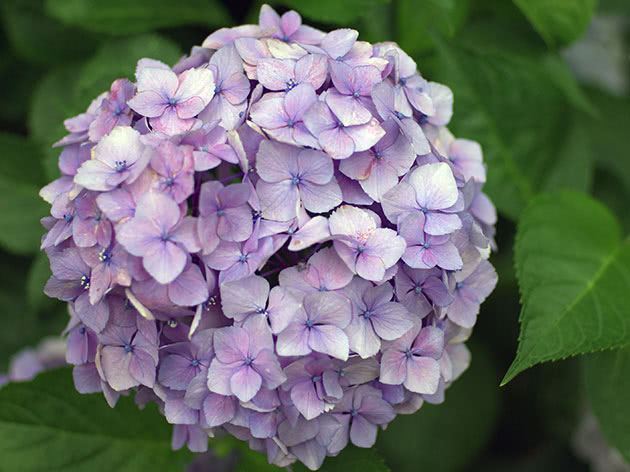
Hydrangea after flowering
When the hydrangea is over with flowering, it is time to winterize the plant. Young seedlings growing in the pots are transferred indoors, and hydrangea species growing in the garden are deadheaded for suddenly fallen wet snow not to stick to them and not to break the fragile branches of the plant. In addition, you will need to earth up the base of the hydrangea bushes and mulch the area on which they grow to reliably protect their superficial root system for the winter. The most cold-resistant species of hydrangeas are panicled and wooly. Their shoots get fully lignified by autumn, so it's easier for them to tolerate winter cold even without being covered, if they do not grow in a cold climate zone. Smooth hydrangea can tolerate a warm winter without a cover.
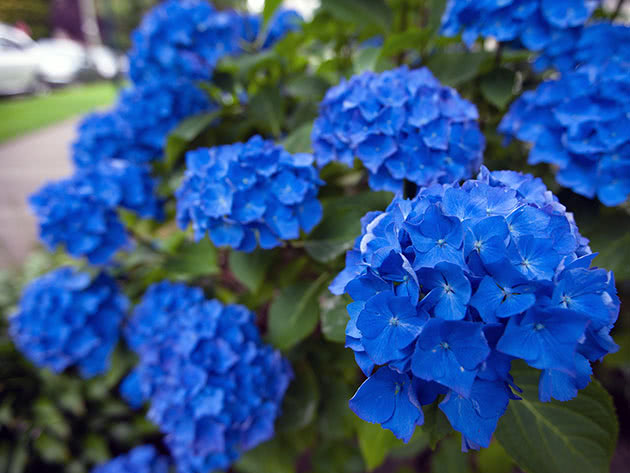
Overwintering of hydrangea
Winterizing of hydrangeas
If the winter is warm and snowy, even heat-loving bigleaf and mountain hydrangea can winter without being covered, but no one will tell you for sure what temperature and what height the snow cover will be in the coming winter. Making assumptions and getting wrong mean ruining your garden, so it's better to be vigilant and be distrustful of predictions to have a good sleep in frosty nights, knowing that your plants also sleep soundly under their warm cover. So, how and when to cover hydrangeas for winter? It is better to do this after the first frost in October. Very young bushes are fully covered with dry soil. The older bushes are bent down to the ground and covered with garden fabric that is fixed with bricks for the wind not to break them. Adult bushes will require more efforts: the bush is neatly tied and wrapped with garden fabric. Then you should set a frame in the form of a cylinder made of metal mesh at a distance of 8-10 inches from the bush, and the frame must be 4 inches above the plant. The space between the frame and hydrangea is filled with dry foliage. In April the frame with foliage can be removed, and when there is a stable warm weather, the garden fabric is taken off.

Hydrangea in winter
It is up to you whether to cover hydrangeas for winter or not. We offer covering options in case of harsh and, most importantly, snowless winter. If there are no severe frosts in your zone, then the cover can be nominal, and if your hydrangea also belongs to winter-hardy species, then it will be no need to protect it from frosts. But if the hydrangea in your garden does not belong to the cold-resistant species, and the winters in your zone are unpredictable, follow our advice in autumn to have a good sleep in winter, and to see hydrangea awake in spring, and to admire its incomparable flowering in summer.

Species of hydrangeas
Before talking about the rules of hydrangea care, you need to know different types of this plant, as each of them has its own requirements. Growing of panicled hydrangea, for example, differs from growing a smooth or bigleaf hydrangea in such important aspects as pruning and winterizing, so the more you know about the species, the easier it will be for you to take care of any of them. So…
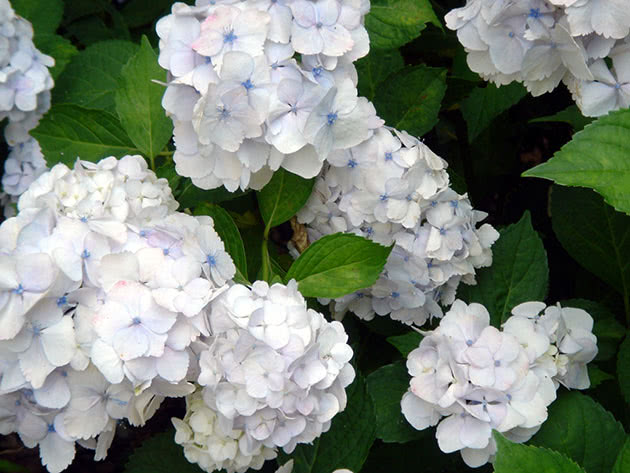
Smooth hydrangea (Hydrangea arborescens)
is a popular species in the gardens of cold climate zone. It is a shrub that reaches a height of 3.3 to 10 ft. Inflorescences are formed at the tips of annual shoots, at the beginning of flowering the flowers are with tints of green, but when they bloom, they turn white or cream. Popular garden forms are Invisible Spirit (pink hydrangea), Sterilis (white hydrangea) that is distinguished by an abundant flowering, hydrangea Annabelle and hydrangea Grandiflora with large snow-white buds that is often confused with panicled hydrangea with the same name.

Panicled hydrangea (Hydrangea paniculata)
grows like a shrub or a tree with a height of 6.6 to 16.4 ft in the wild. In garden cultivation it is one of the most popular species. In one place panicled hydrangea can grow more than forty years. Its shoots quickly become lignified that makes this species resistant to cold. Inflorescences are formed at the tips of the current year shoots, so the flowering is very abundant, although the buds emerging at the end of June open only by August or September. Inflorescence of panicled hydrangea has a pyramidal shape, the flowers are with tints of green at the very beginning of flowering, then they turn white, in autumn they become pink, then brick-red and at the end of flowering they again get a greenish tinge. The most famous garden varieties are Grandiflora, hydrangea Vanille Fraise, Kyushu, Tardiva.
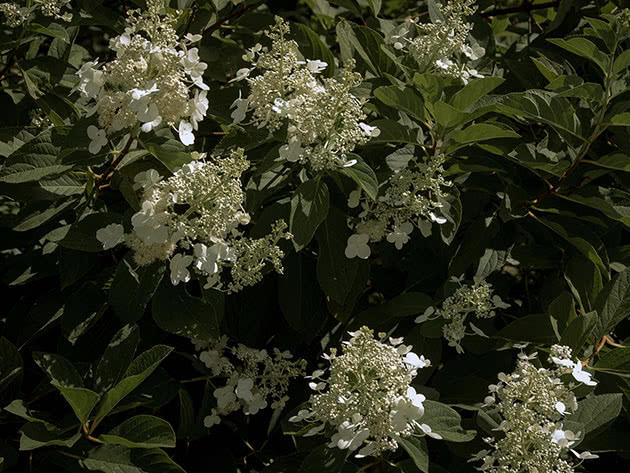
Bigleaf hydrangea (Hydrangea macrophylla)
that is also called French hydrangea is the most popular in the gardens, but there are compact varieties that can be grown in containers on terraces and even in the house. This species has the dense foliage of bright green color, the shoots of the current year are herbaceous, so the plant has a very low cold resistance. However, the buds for shoots of the current year at the ends of which the inflorescences open are set in the previous autumn, so it is believed that the big-leaf hydrangea blooms on last year's shoots. The shape of the inflorescence is usually umbellate, or hemispherical. The color of the flowers depends on the pH level of the soil. The most interesting cold-resistant varieties that have been recently bred are: Endless Summer is a blue hydrangea if it is grown in acidic soil, and lilac if it is grown in neutral soil; Renata Steiniger is a blue hydrangea; Romance and Expression are the varieties with double flowers.
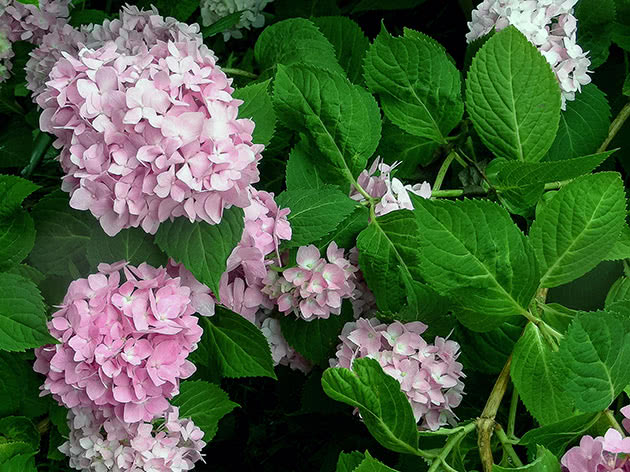
Oak leaf hydrangea (Hydrangea quercifolia)
is a very attractive species, but, unfortunately, it is not winter-hardy at all, so it requires warming cover for winter. It impresses not only with magnificent flowering, but also with leaves of an unusual shape. The hydrangea grows up to 6.6 ft in height, has panicled inflorescence 4-12 inches in length with white flowers at the beginning of flowering, and over time they turn purple and fully open in June-July.

Wooly hydrangea (Hydrangea heteromalla)
or Himalayan hydrangea is a frost-resistant species, reaching 6.6 or 10 ft in height in the wild. In cultivation, it is often used to form a stem-tree. Dark green leaves are 8 inches long and have a smooth surface and downy, pubescent underside, inflorescences are loose, corymbose, initially they are white, but at the end of flowering they turn pink. It blooms in late June or early July. Hydrangea bretschneideri is especially popular variety of wooly hydrangea, it blooms vigorously with large milky-white inflorescences.
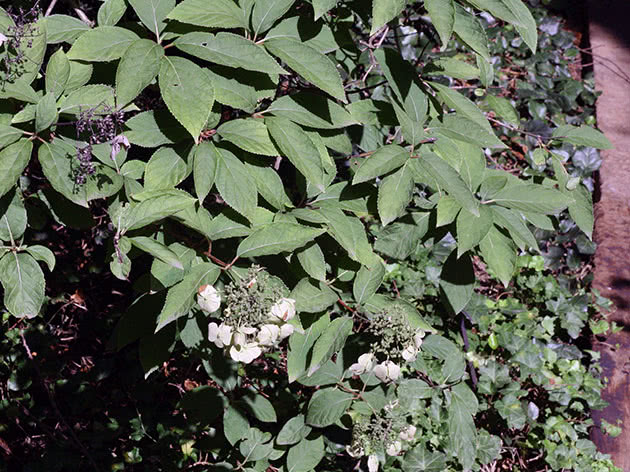
In addition to these species, the gardeners are also interested in silverleaf hydrangea, ashy hydrangea, rough-leaf hydrangea, mountain hydrangea, Sargent hydrangea, and a climbing hydrangea that only looks like a hydrangea but it is not hydrangea.
